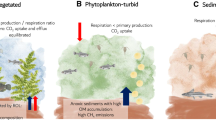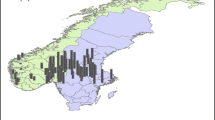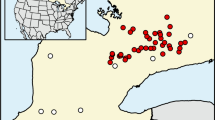Abstract
Dynamics of greenhouse gases, CH4, CO2 and N2O, and nutrients, NO −2 + NO −3 , NH +4 and P, were studied in the sediments of the eutrophic, boreal Lake Kevätön in Finland. Undisturbed sediment cores taken in the summer, autumn and winter from the deep and shallow profundal and from the littoral were incubated in laboratory microcosms under aerobic and anaerobic water flow conditions. An increase in the availability of oxygen in water overlying the sediments reduced the release of CH4, NH +4 and P, increased the flux of N2O and NO −2 + NO −3 , but did not affect CO2 production. The littoral sediments produced CO2 and CH4 at high rates, but released only negligible amounts of nutrients. The deep profundal sediments, with highest carbon content, possessed the greatest release rates of CO2, CH4, NH +4 and P. The higher fluxes of these gases in summer and autumn than in winter were probably due to the supply of fresh organic matter from primary production. From the shallow profundal sediments fluxes of CH4, NH4 + and P were low, but, in contrast, production of N2O was the highest among the different sampling sites. Due to the large areal extension, the littoral and shallow profundal zones had the greatest importance in the overall gas and nutrient budgets in the lake. Methane emissions, especially the ebullition of CH4 (up to 84% of the total flux), were closely related to the sediment P and NH +4 release. The high production and ebullition of CH4, enhances the internal loading of nutrients, lake eutrophication status and the impact of boreal lakes to trophospheric gas budgets.
Similar content being viewed by others
References
Adams D.D. and Fendinger N.J. 1985. Early Diagenesis of organic matter in the recent sediments of Lake Erie and Hamilton Harbor I. Carbon Gas Geochemistry. In: Sly P.G. (ed.), Sediment and Water Interactions. Proceedings of the Third International Symposium on Interactions Between Sediments and Water, Geneva, Swizerland, August 27–31, 1984. Springer-Verlag, Berlin, pp. 305–317.
Boström B., Andersen J.M., Fleischer S. and Jansson M. 1988. Exchange of phosphorus across the sediment-water interface. Hydrobiol. 170: 229–244.
Casper P. 1996. Methane production in littoral and profundal sediments of an oligotrophic and a eutrophic lake. Arch. Hydrobiol. Adv. Limnol. 48: 253–259.
Cicerone R.J. and Oremland R.S. 1988. Biogeochemical aspects of atmospheric methane. Global Biogeochem. Cycles 2: 299–327.
Cole J.J., Caraco N.F., Kling G.W. and Kratz T.K. 1994. Carbon dioxide supersaturation in the surface waters of lakes. Science 265: 1568–1570.
den Hayer C. and Kalff J. 1998. Organic matter mineralization rates in sediments: A within-and amonglake study. Limnol. Oceanogr. 43: 695–705.
De Pinto J.V. and Verhoff F.H. 1977. Nutrient regeneration from aerobic decomposition of green algae. Environ. Sci. Technol. 11: 371–377.
Huttunen J.T., Hammar T., Alm J., Silvola J. and Martikainen P.J. 2001. Greenhouse gases in non-oxygenated and artificially oxygenated eutrophied lakes during winter stratification. J. Environ. Qual. 30: 387–394.
Huttunen J.T., Mäntynen K., Alm J., Hammar T., Silvola J. and Martikainen P.J. 1999. Pelagic methane emissions from three boreal lakes with different trophy. In: Kuusisto S., Isoaho S. and Puhakka J. (eds), Proceedings of 4th Finnish Conference of Environmental Science, Tampere, Finland, May 21–22, 1999. Environmental Science, Technology and Policy, Water and Environmental Engineering Report 9. Tampere University of Technology, Tampere, Finland, pp. 152–154.
Håkanson L. and Jansson J. 1983. Principles of Lake Sedimentology. Springer-Verlag, Berlin, Heidelberg, Germany.
IPCC 1996. Climate Change 1995: The Science of Climate Change. In: Houghton J.T., Meira Filho L.G., Callender B.A., Harris N., Kattenberg A. and Maskell K. (eds), Contribution ofWorking Group I to the Second Assessment Report of the IPCC. Cambridge Univ. Press, Cambridge, UK.
Jones J.G. 1982. Activities of aerobic and anaerobic bacteria in lake sediments and their effect on the water column. In: Nedwell D.B. and Brown C.M. (eds), Sediment Microbiology. Academic Press Inc. Ltd., London, pp. 107–145.
Jones J.G. and Simon B.M. 1980. Decomposition processes in the profundal region of Belham Tarn and Lund tubes. J. Ecol. 68: 493–512.
Jones J.G. and Simon B.M. 1981. Differences in microbial decomposition processes in profundal and littoral lake sediments, with particular reference to the nitrogen cycle. J. Ecol. 123: 297–312.
Juutinen S., Alm J., Martikainen P.J. and Silvola J. 2001. Effects of spring flood and water level drawdown on methane dynamics in the littoral zone of boreal lakes. Freshwat. Biol. 46: 855–869.
Kelley C.A., Martens C.S. and Chanton J.P. 1990. Variations in sedimentary carbon remineralization rates in the White Oak River estuary, North Carolina. Limnol. Oceanogr. 35: 372–383.
Kelly C.A. and Chynoweth D.P. 1981. The contributions of temperature and of the input of organic matter in controlling rates of sediment methanogenesis. Limnol. Oceanogr. 26: 891–897.
Kelly C.A., Rudd J.W.M. and Schindler D.W. 1988. Carbon and electron flow via methanogenesis, SO4 2-,NO3-, Fe3+, and Mn4+ reduction in the anaerobic hypolimnia of three lakes. Arch. Hydrobiol. Beih. Ergebn. Limnol. 31: 333–344.
Keskitalo J. and Salonen K. 1994. Manual for integrated monitoring-subprogram hydrobiology of lakes. Publications of the Water and Environment Administration - series B 16. National Board of Waters and the Environment, Helsinki, Finland.
Lide D.R. and Fredrikse H.P.R. 1995. CRC handbook of chemistry and physics. 76th edn. CRC Press, Boca Raton, FL, USA.
Liikanen A., Flöjt L. and Martikainen P.J. 2002a. Gas dynamics in eutrophic lake sediments affected by oxygen, nitrate and sulfate. J. Environ. Qual. 31: 338–349.
Liikanen A., Huttunen J., Valli K. and Martikainen P.J. 2002b. Methane cycling in the sediment and water column of mid-boreal hyper-eutrophic Lake Kevätön, Finland. Archiv für Hydrobiologie 154: 585–603.
Liikanen A., Tanskanen H., Murtoniemi T. and Martikainen P.J. 2002c. A laboratory microcosm for simultaneous gas and nutrient flux measurements in sediments. Boreal Environ. Res. 7 7: 151–160.
Liikanen A., Murtoniemi T., Tanskanen H., Väisänen T. and Martikainen P.J. 2002d. Effects of temperature and oxygen availability on greenhouse gas and nutrient dynamics in sediment of a eutrophic boreal lake. Biogeochem. 59: 269–286.
Matinvesi J. 1996. The change of sediment composition during recovery of two Finnish lakes induced by wastewater purification and lake oxygenation. Hydrobiol. 335: 193–202.
Nakamura T., Nojiri Y., Utsumi M., Nozawa T. and Otsuki A. 1999. Methane emission to the atmosphere and cycling in a shallow eutrophic lake. Arch. Hydrobiol. 144: 383–407.
Nykänen H., Alm J., Lång K., Silvola J. and Martikainen P.J. 1995. Emissions of CH4, N2O and CO2 from a virgin fen and a fen drained for grassland in Finland. J. Biogeogr. 22: 351–357.
Rich P.H. 1978. Analysis of five North American lake ecosystems VII: Sediment processing. Verh. Internat. Verein. Limnol. 20: 598–604.
Seitzinger S.P. and Kroeze C. 1998. Global distribution of nitrous oxide production and N inputs in freshwater and coastal marine ecosystems. Global Biogeochem. Cycles 12: 93–113.
SFS Standardization 1976. SFS-3032. Determination of ammonium-nitrogen of water.
SFS Standardization 1986. SFS-3026. Determination of total phosphorus in water. Digestion with peroxodisulfate.
SFS Standardization 1995. SFS-EN 25813. Water quality. Determination of dissolved oxygen. Iodometric method.
SFS Standardization 1997. SFS-EN ISO 13395. Water quality. Determination of nitrite nitrogen and nitrate nitrogen and the sum of both by flow analysis (CFA and FIA) and spectrometric detection.
Sinke A.J.C., Cornelese A.A., Keizer P., van Tongener O.F.R. and Cappenberg T.E. 1990. Mineralization, pore water chemistry and phosphorus release from peaty sediments in the eutrophic Loosdrecht lakes, The Netherlands. Freshwat. Biol. 23: 587–599.
Sweerts J.-P.R.A., Bär-Gilissen M.-J., Cornelese A.A. and Cappenberg T.E. 1991. Oxygen-consuming processes at the profundal and littoral sediment-water interface of a small meso-eutrophic lake (Lake Vechten, The Netherlands). Limnol. Oceanogr 36: 1124–1133.
Thebrath B., Rothfuss F., Whiticar M.J. and Conrad R. 1993. Methane production in littoral sediment of Lake Constance. FEMS Microbiol. Ecol. 102: 279–289.
Wetzel R.G. 1975. Limnology. 1st edn. Saunders College Publication, Philadelphia.
Winfrey M.R. and Zeikus J.G. 1979. Anaerobic metabolism of immediate methane precursors in Lake Mendota. Appl. Environ. Microbiol. 37: 244–253.
Rights and permissions
About this article
Cite this article
Liikanen, A., Huttunen, J.T., Murtoniemi, T. et al. Spatial and seasonal variation in greenhouse gas and nutrient dynamics and their interactions in the sediments of a boreal eutrophic lake. Biogeochemistry 65, 83–103 (2003). https://doi.org/10.1023/A:1026070209387
Issue Date:
DOI: https://doi.org/10.1023/A:1026070209387




